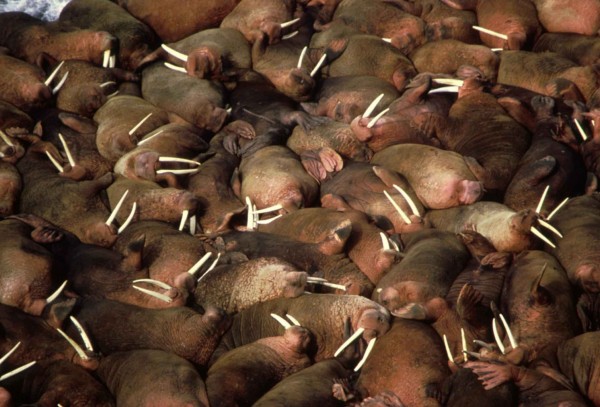35,000 Walruses Stranded on North Alaskan Beach; Plight Blamed On Climate Change
| Ana Verayo | | Oct 02, 2014 05:27 AM EDT |
(Photo : Sarvis John, U.S. Fish and Wildlife Service) A group of walruses is called a lek and it can be dangerous for them to huddle together on a massive scale
An estimated 35,000 walruses have been spotted on a small strip of beach in northwest Alaska, stranded there by a massive loss of sea ice.
Climate change has caused rapid sea ice melting and this loss of ses ice isn't a good thing for the walruses. Even if they're sea mammals, walruses can't swim long distances at a continuous rate. Sea ice, therefore, has long provided tired walruses a temporary resting ground.
Like Us on Facebook
The beach inundated by this colossal group of walruses, called a lek, is located around five miles north of Point Lay. Observers spotted the walruses on the beach on September 13.
They also saw waves of these huge animals stampede leaving as many as 50 carcasses on the shoreline. The National Oceanic and Atmospheric Administration documented the situation as their marine aerial probes captured images of the lek fighting for survival.
Photos also showed the walruses using their tusks to haul themselves out of the water and onto the shoreline.
Researchers said that because the amount of sea ice in shallow regions has melted into the oceans, these walruses can no longer thrive and are forced to find other places to migrate as huge populations huddle together.
This lek can be deadly to the walruses, which are easily scared and can easily stampede. In 2009, a lek stampede left 130 carcasses, mostly young or baby walruses, in Alaska's Icy Cape.
This colossal number of walruses gathering at a certain place is a clear result of climate change, said researchers. They said it's urgent for the rest of the world to take immediate action to tackle the root causes of this global problem.
Tags35, 000 Walruses Stranded on Beach in North Alaska; Blame It On Climate Change, walrus, walruses north alaska climate change, Alaska
©2015 Chinatopix All rights reserved. Do not reproduce without permission
EDITOR'S PICKS
-

Did the Trump administration just announce plans for a trade war with ‘hostile’ China and Russia?
-

US Senate passes Taiwan travel bill slammed by China
-

As Yan Sihong’s family grieves, here are other Chinese students who went missing abroad. Some have never been found
-

Beijing blasts Western critics who ‘smear China’ with the term sharp power
-

China Envoy Seeks to Defuse Tensions With U.S. as a Trade War Brews
-

Singapore's Deputy PM Provides Bitcoin Vote of Confidence Amid China's Blanket Bans
-

China warns investors over risks in overseas virtual currency trading
-

Chinese government most trustworthy: survey
-

Kashima Antlers On Course For Back-To-Back Titles
MOST POPULAR
LATEST NEWS
Zhou Yongkang: China's Former Security Chief Sentenced to Life in Prison

China's former Chief of the Ministry of Public Security, Zhou Yongkang, has been given a life sentence after he was found guilty of abusing his office, bribery and deliberately ... Full Article
TRENDING STORY

China Pork Prices Expected to Stabilize As The Supplies Recover

Elephone P9000 Smartphone is now on Sale on Amazon India

There's a Big Chance Cliffhangers Won't Still Be Resolved When Grey's Anatomy Season 13 Returns

Supreme Court Ruled on Samsung vs Apple Dispute for Patent Infringement

Microsoft Surface Pro 5 Rumors and Release Date: What is the Latest?










